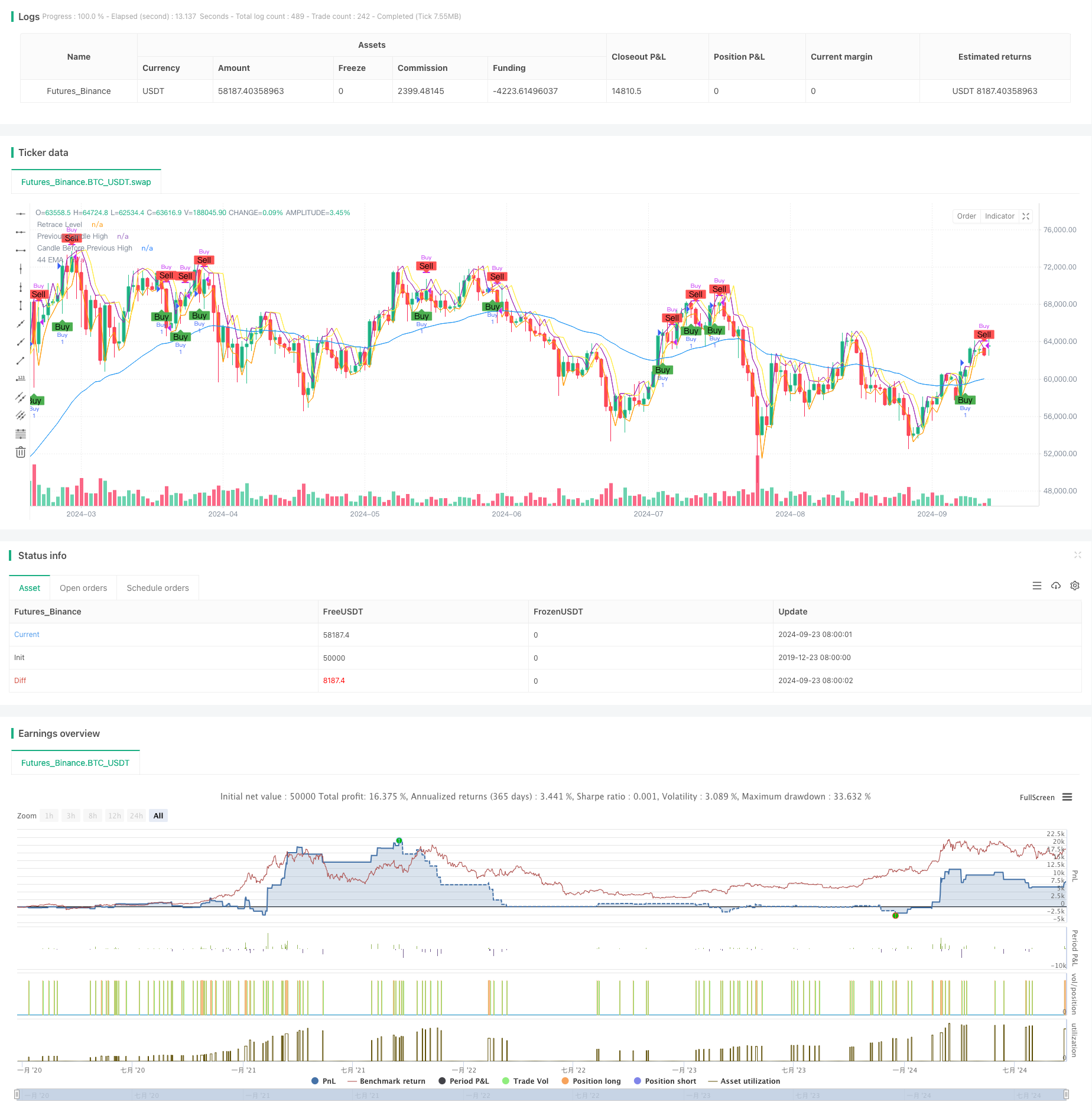
概述
这是一个基于44周期指数移动平均线(EMA)的趋势跟踪策略。该策略主要在上升趋势中寻找买入机会,通过分析EMA斜率、蜡烛图形态以及价格回撤等多个条件来确定入场时机。策略设计适用于2分钟和5分钟等较短时间周期,旨在捕捉短期价格波动中的交易机会。
策略原理
- 计算44周期EMA及其斜率,判断趋势是否足够倾斜。
- 分析前一根蜡烛的形态,要求其为阳线且收盘价高于EMA。
- 观察当前蜡烛是否回撤到前一根蜡烛实体的50%位置。
- 确保前一根蜡烛的收盘价高于更早一根蜡烛的最高价,以验证上升趋势的持续性。
- 当所有条件满足时,在当前蜡烛的回撤位置开仓做多。
- 出场条件为:前一根蜡烛为阴线或当前蜡烛低点跌破前一根蜡烛低点。
策略优势
- 多重过滤:结合EMA、蜡烛图形态和价格回撤等多个指标,有效降低虚假信号。
- 趋势跟随:通过EMA斜率判断确保在明确上升趋势中交易,提高胜率。
- 回撤入场:利用价格回撤作为入场点,优化买入价格,potentially提高盈利空间。
- 灵活性强:可应用于不同时间周期,适合短线和日内交易者。
- 风险控制:设有明确的止损条件,有助于控制每次交易的风险。
策略风险
- 滞后性:EMA作为滞后指标,可能在剧烈波动行情中反应不及时。
- 假突破:在横盘整理区间可能产生频繁的假突破信号。
- 过度交易:在高波动市场可能触发过多交易,增加交易成本。
- 趋势逆转:快速的趋势逆转可能导致较大亏损。
- 参数敏感性:策略效果对EMA周期等参数设置较为敏感。
策略优化方向
- 引入额外过滤器:如RSI或MACD,进一步确认趋势强度和方向。
- 动态止损:使用ATR指标设置动态止损,更好地适应市场波动。
- 增加成交量分析:结合成交量指标,提高入场信号的可靠性。
- 优化EMA周期:通过回测不同的EMA周期,找出最优参数组合。
- 加入趋势强度指标:如ADX,确保只在强劲趋势中入场。
- 改进出场机制:设计更精细的获利了结策略,如trailing stop。
总结
高斯交叉EMA趋势滑点追踪策略是一个结合多重技术指标的趋势跟踪系统。通过EMA、蜡烛图形态分析和价格回撤等多维度判断,该策略在识别上升趋势和优化入场时机方面展现出良好的潜力。然而,使用者需要注意控制过度交易风险,并针对不同市场环境进行参数优化。通过引入额外的技术指标和改进风险管理机制,该策略有望在短期交易中取得更稳定的表现。
策略源码
/*backtest
start: 2019-12-23 08:00:00
end: 2024-09-24 08:00:00
period: 1d
basePeriod: 1d
exchanges: [{"eid":"Futures_Binance","currency":"BTC_USDT"}]
*/
//@version=5
strategy("Custom Strategy with EMA and Candle Conditions", overlay=true)
// Define parameters
ema_length = 44
// Calculate EMA
ema_44 = ta.ema(close, ema_length)
// Calculate the slope of the EMA
ema_slope = ta.ema(close, ema_length) - ta.ema(close[9], ema_length)
// Define a threshold for considering the EMA flat
flat_threshold = 0.5
// Check if the EMA is flat or inclined
ema_is_inclined = math.abs(ema_slope) > flat_threshold
// Define the previous candle details
prev_candle_high = high[1]
prev_candle_low = low[1]
prev_candle_close = close[1]
prev_candle_open = open[1]
// Candle before the previous candle (for high comparison)
candle_before_prev_high = high[2]
// Current candle details
current_candle_high = high
current_candle_low = low
current_candle_close = close
current_candle_open = open
// Previous to previous candle details
prev_prev_candle_low = low[2]
// Previous candle body and wick length
prev_candle_body = math.abs(prev_candle_close - prev_candle_open)
prev_candle_wick_length = math.max(prev_candle_high - prev_candle_close, prev_candle_close - prev_candle_low)
// Calculate retrace level for the current candle
retrace_level = prev_candle_close - (prev_candle_close - prev_candle_low) * 0.5
// Check if the previous candle's wick is smaller than its body
prev_candle_condition = prev_candle_wick_length < prev_candle_body
// Check if the previous candle is a green (bullish) candle and if the previous candle's close is above EMA
prev_candle_green = prev_candle_close > prev_candle_open
prev_candle_red = prev_candle_close < prev_candle_open
prev_candle_above_ema = prev_candle_close > ema_44
// Entry condition: The current candle has retraced to 50% of the previous candle's range, previous candle was green and above EMA, and the high of the current candle is above the retrace level, and EMA is inclined
entry_condition = prev_candle_close > candle_before_prev_high and
prev_candle_green and
prev_candle_above_ema and
current_candle_low <= retrace_level and
current_candle_high >= retrace_level and ema_is_inclined
// Exit condition
exit_condition = (strategy.position_size > 0 and prev_candle_red) or (strategy.position_size > 0 and current_candle_low < prev_candle_low)
// Ensure only one trade is open at a time
single_trade_condition = strategy.position_size == 0
// Plot EMA for visualization
plot(ema_44, color=color.blue, title="44 EMA")
// Plot conditions for debugging
plotshape(series=entry_condition and single_trade_condition, location=location.belowbar, color=color.green, style=shape.labelup, text="Buy")
plotshape(series=exit_condition, location=location.abovebar, color=color.red, style=shape.labeldown, text="Sell")
// Print entry condition value on chart
var label entry_label = na
if (entry_condition and single_trade_condition)
entry_label := label.new(bar_index, low, text="Entry Condition: TRUE", color=color.green, textcolor=color.white, size=size.small, yloc=yloc.belowbar)
else
entry_label := label.new(bar_index, high, text="Entry Condition: FALSE", color=color.red, textcolor=color.white, size=size.small, yloc=yloc.abovebar)
// Debugging: Plot retrace level and other key values
plot(retrace_level, color=color.orange, title="Retrace Level")
plot(prev_candle_high, color=color.purple, title="Previous Candle High")
plot(candle_before_prev_high, color=color.yellow, title="Candle Before Previous High")
// Trigger buy order if entry condition and single trade condition are met
if (entry_condition and single_trade_condition)
strategy.entry("Buy", strategy.long)
// Trigger sell order if exit condition is met
if (exit_condition)
strategy.close("Buy")
相关推荐